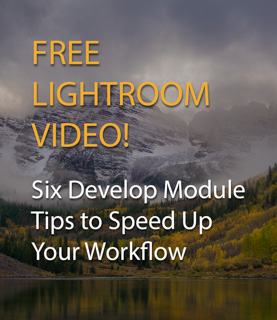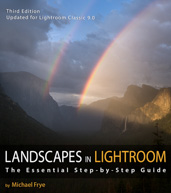In the Moment:
Michael Frye's Landscape Photography Blog
by Michael Frye | Jan 3, 2018 | Announcements
The votes are all in and counted, and here are my top photographs of 2017!
We had a great response this year: 370 people looked through my initial selection of 35 images and voted for their favorites here on the blog, Facebook, Google+, and through email. A big thank you to everyone who took the time to look through these photographs and voice your opinions! I also really appreciate all the kind words expressed along with the votes. I wish I could respond to every comment and email, but please know that I’ve read them all and am very grateful for all your support. And also, many thanks to my wonderful assistant Claudia who tallied all those votes!
(more…)
by Michael Frye | Dec 31, 2017 | Announcements
(I’ve closed comments on this post, since the voting deadline has passed. You can see the final selections here. Thanks to all of you who voted!)
Happy New Year!
Like champagne, Auld Land Syne, and the Tournament of Roses Parade, it’s become a New Year’s tradition on this blog to pick my best images from the past year, and once again I’m inviting you to help me make these difficult choices. I’ve posted 35 of my best photographs from 2017 below, in chronological order. After you look through these, please post a comment listing your ten favorites.
You don’t have to list your ten favorites in any order, or even name them – just numbers will do. (The numbers are in the captions underneath the photographs. Also, you can click on the images to see them larger.) Once the votes are in I’ll post the top ten on this blog, and submit the final group to Jim Goldstein’s blog project, where he’ll be showcasing the best images of the year from over 300 photographers. The voting deadline is this Tuesday, January 2nd, at midnight Pacific time.
(more…)
by Michael Frye | Dec 24, 2017 | Announcements
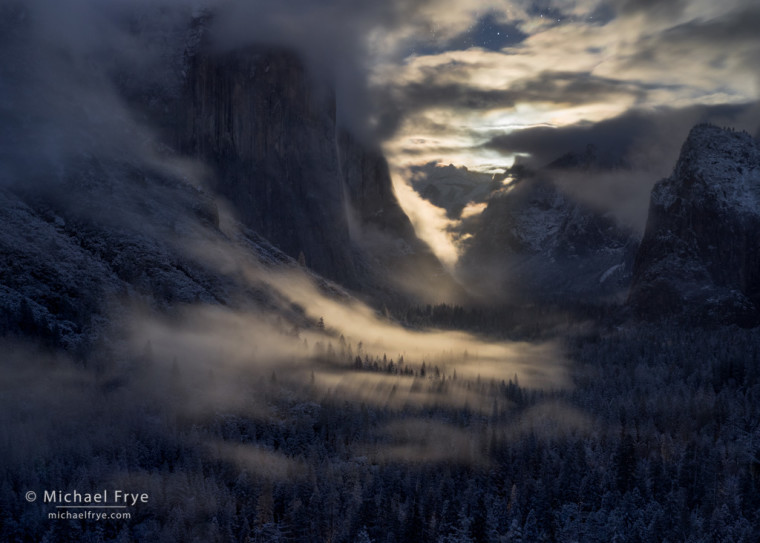
Clearing storm by moonlight from Tunnel View, Yosemite
This photograph was made on a magical winter night two years ago, as the moon rose over Yosemite Valley while a snowstorm was clearing. As I wrote back then, I was glad to be a landscape photographer, because what other pursuit involves deliberately seeking out our planet’s most beautiful events?
But the most special moments in our lives are usually the ones we spend with the people we love. I hope your Christmas is filled with beautiful moments in the company of family and friends. To all who celebrate it, Claudia and I wish you a very Merry Christmas!
— Michael Frye
by Michael Frye | Dec 17, 2017 | Composition
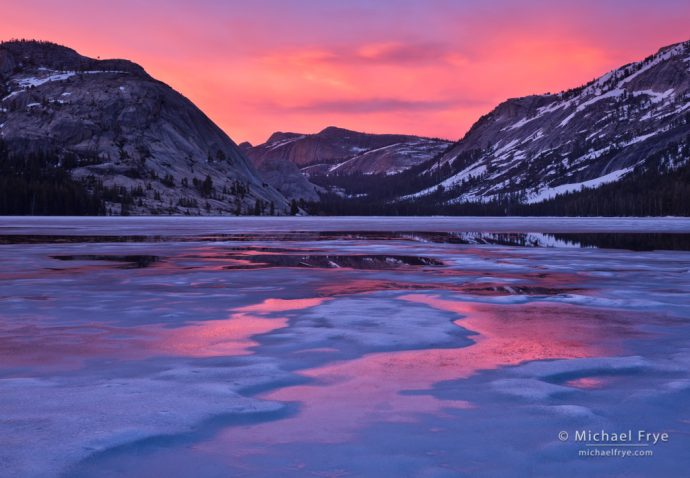
Sunset at Tenaya Lake, Yosemite. I had to work quickly to find a foreground design to go with this colorful sunset.
I’ve always been attracted to color. Color can be eye-catching, but more importantly to me, it’s a powerful tool for conveying a mood.
My attention is easily caught by colorful subjects like flowers, fall leaves, sunrise or sunset clouds, reflections, and so on. The colors don’t have to be bold; a subtle color palette can be just as compelling.
But while interesting colors always catch my eye, I know that color is not enough by itself. You can’t just point your camera toward something colorful and expect to make a great photograph. A frame filled with a random mishmash of autumn leaves won’t be compelling – it’ll just be a colorful mess. You need to find a design to go with that color. So I’m always looking for focal points and patterns that could help give structure to the color.
(more…)
by Michael Frye | Dec 10, 2017 | Composition
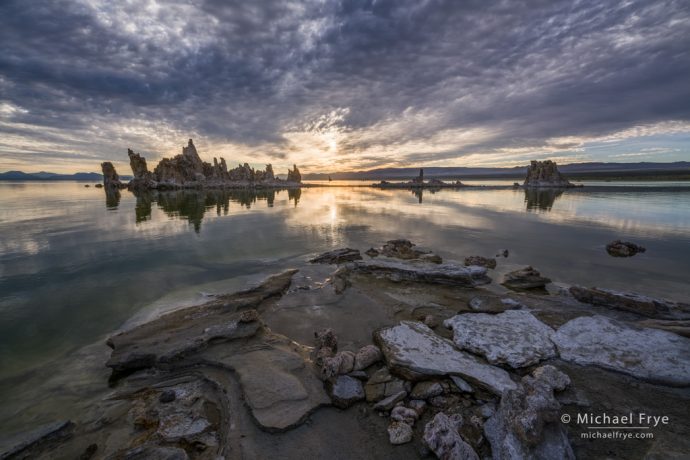
A: Morning light and clouds, Mono Lake. Can you guess what kind of lens I used for this photograph?
When I post a photograph, people often ask me which lens I used. I’m happy to tell them, but I don’t think you learn much when someone hands you an answer. I think it’s more instructive to try to guess yourself. Estimating what lens focal length a photographer used can help train your eye to see the world the way the camera sees, and learn how lenses control the sense of depth and perspective in a photograph. And those things will help you find compositions more readily, and make it easier to choose which lens to use in the field.
Wide-angle lenses often create a sense of depth, and immerse you into the landscape, while telephoto lenses flatten the perspective and isolate small parts of a scene. Telephotos are also great for creating patterns. Those traits aren’t always apparent, however, nor are they exclusive. You can show patterns with wide-angle lenses, and you can convey a sense of depth with telephoto lenses. And you can photograph intimate landscapes with wide-angle lenses, and show a vast, sweeping landscape with a telephoto.
(more…)
by Michael Frye | Nov 26, 2017 | Reviews
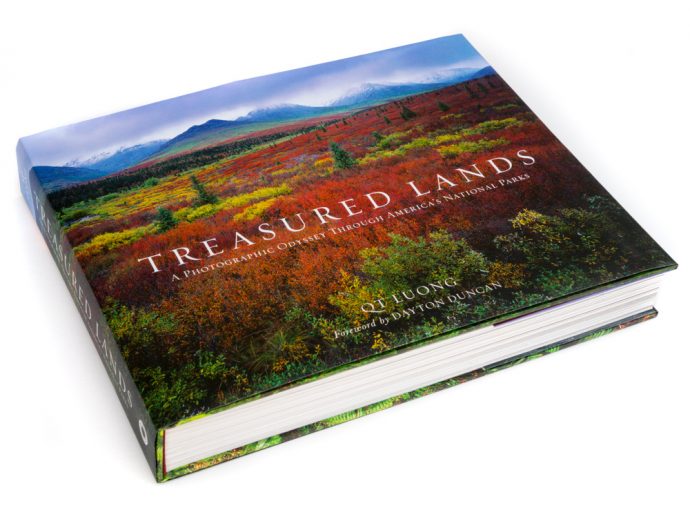
I don’t often post reviews here, but QT Luong’s Treasured Lands is a book I thought you should know about, and QT is currently having a sale on signed copies.
Treasured Lands is a big, beautiful, coffee-table book with photographs of all 59 U.S. national parks. Just visiting all 59 parks would be quite an achievement, but to make artistic photographs of all these places in different seasons and varying weather conditions is an amazing feat. It’s not surprising that it took QT twenty years to accomplish this.
(more…)
by Michael Frye | Nov 22, 2017 | Announcements
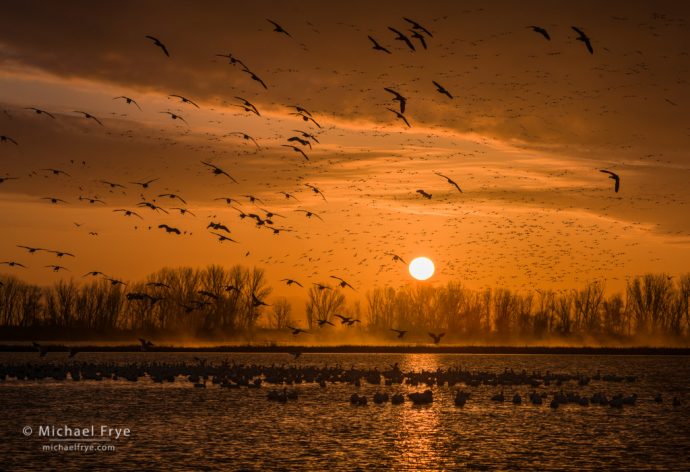
Ross’s geese at sunrise, San Joaquin Valley, CA, USA
The Thanksgiving holiday is always a good time to pause from our daily routines and think about all the things we have to be grateful for.
For me, first and foremost, I’m thankful for my family and friends. I’m happy that my son has flown the nest and is doing so well, and I’m especially fortunate to have been married to the same wonderful, beautiful woman for over 30 years.
And I’m extremely grateful for all the support I receive from you, my readers. Your comments and emails help make writing this blog fun, and keep me motivated and inspired. Thank you!
Whether or not you celebrate Thanksgiving, I hope you all have a lot to be thankful for!
— Michael Frye
by Michael Frye | Nov 12, 2017 | Light and Weather, Travels and Stories
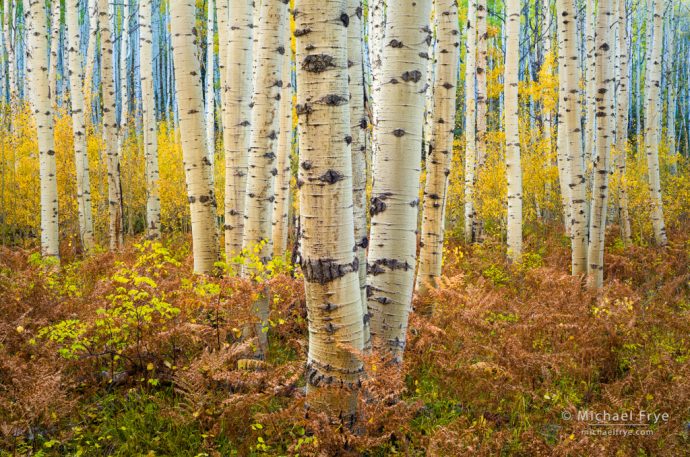
Aspens and ferns, autumn, Grand Mesa-Uncompahgre-Gunnison NF, CO, USA
Claudia and I had wonderful conditions on our autumn trip to Colorado. As I said before, it wasn’t the best year for fall color there, but the weather more than made up for that, with rain, snow, fog, and lots of interesting clouds.
We chased the weather and color all over Colorado – or so it seemed. We reached the San Juan Mountains in the southwest corner of the state on September 27th, but found little color at that time. So we headed east and ended up near Twin Lakes, where I photographed aspens with snow and fog. Then we drove over Independence Pass and spent a couple of days around Aspen and Carbondale, braving the crowds to capture a misty view of the Maroon Bells.
(more…)
by Michael Frye | Nov 5, 2017 | Advanced Techniques

Late-October aspens near Silver Lake, June Lake Loop, Inyo NF, CA, USA. I used f/16 to get everything in focus in this 2008 photograph from the eastern Sierra. (The shutter speed was 1/6th second, the ISO 400.)
I sometimes post my camera settings here on the blog, and I’ve had many people ask me why I often use f/16. Is that the sharpest aperture on my lens? (No.) Don’t you get diffraction at f/16? (A little bit.) Is it for depth of field? (Bingo!)
As many of you know, most lenses are sharpest at middle apertures – generally around f/5.6 to f/11, depending on the lens.
Better lenses will perform decently at wide apertures like f/2.8 or f/4, but usually the corners are softer compared to the middle apertures. On the other end of the spectrum, at smaller apertures diffraction causes all lenses to get softer over the entire image (not just the corners).
(more…)
by Michael Frye | Oct 29, 2017 | Light and Weather, Yosemite Photo Conditions
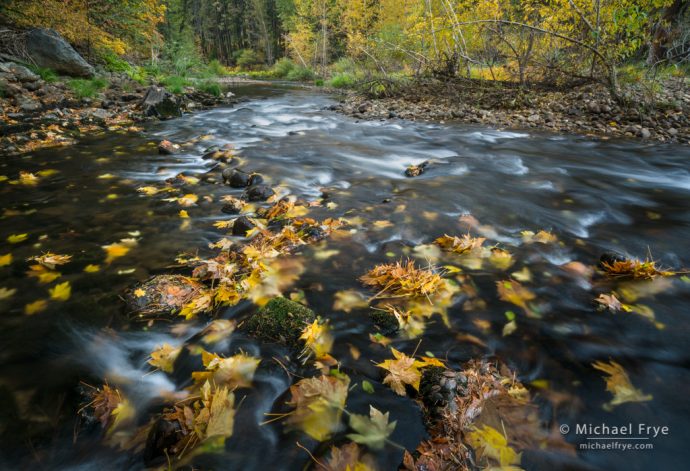
Big-leaf maple leaves along the Merced River, autumn, Yosemite. 19mm, 2 seconds at f/16, ISO 100, polarizer.
Claudia and I spent Friday in Yosemite Valley checking out the fall color. And it was beautiful. The big-leaf maples, in particular, were quite colorful.
It was a clear, sunny day, so there wasn’t any weather to add drama to the valley landscapes. When the weather and light aren’t that interesting I tend to narrow my focus and photograph smaller subjects. And for those subjects, conditions were perfect. The low autumn sunlight kept some parts of the valley in shade virtually all day, and that soft light was perfect for highlighting the autumn color. Plus, from the south side of the Merced River you could look toward sunlit cliffs on the north side of the valley and find beautiful, golden reflections in the shaded water.
(more…)









